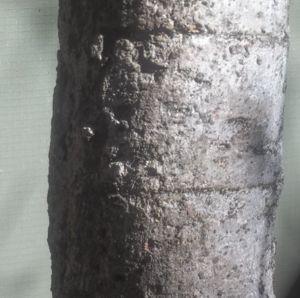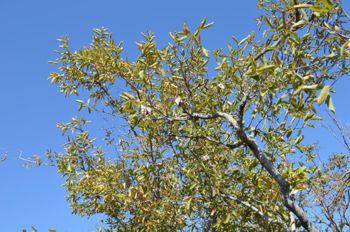Combretum zeyheri
Combretum zeyheri Sond.
Family: Combretaceae
Common names: large-fruited bushwillow, Zeyher’s bushwillow (Eng.); raasblaar, fluisterboom (Afr.); moduba-tshipi (Sepedi); umbondwe wasembudwini (isi Zulu); mufhatelathundu (Vhenda)
SA Tree No: 546
Introduction
Combretum zeyheri is a bushveld tree, with a rounded crown shape, single or multi-stemmed, with the bark that is smooth and whitish in colour. It is an attractive tree that should be utilized more often in gardens because of its beautiful scented flowers and extra-ordinary fruits that are the largest all Combretaceae. It gives a good show from September to July.

Description
Description
Combretum zeyheri is a deciduous or semi-deciduous tree of up to 10–15 m high, with a rounded crown, branched and often with twisted trunks. Bark on younger stem is whitish and hairy; stems have prominently thickened nodes, smooth and flaking; small twigs are reddish and drooping.

Leaves are simple, opposite, sometimes is whorls of three on young branches, elliptic to obovate. Young leaves are soft and hairy, rounded with broadly tapering tips and bases. The older leaves are typically larger, bigger than those of any other species of Combretum; they are approximately about 80 mm long and 40 mm wide. Margins are entire. Net veining is visible on both surfaces, yellowish green to light green and also with a yellowish autumn colour.

Flowers are yellow-green with orange anthers, with a strong sweet scent, sessile and borne in spikes, which appear in attractive clusters in spring before the leaves.
Fruits are large, orange-brown when dry, with four wings typically of the genus, 80 mm in diameter.


Conservation Status
Status
Combretum zeyheri is regarded as LT (Least Threatened) according to the Red List of southern African plants.
Distribution and habitat
Distribution description
Combretum zeyheri is found in Mpumalanga, Limpopo, Gauteng and North West, often in acidic and sandy soil. These provinces have summer rainfall and it occurs in bushveld, wooded grassland, rocky slopes and riverine woodland.
Derivation of name and historical aspects
History
Combretum is the name given by Pliny for a climbing plant, the identity of which has been lost in time; zeyheri refers to Carl L.P Zeyher (1799–1858), a German naturalist who first collected this species on the Magaliesburg range.
Ecology
Ecology
Three species of butterfly are recorded as using this species as their larval (caterpillar) food plant viz. The Apricot Playboy (Deudorix dinochares); Guineafowl Butterfly (Hamanumida daedalus); and (Niepeltia zeyheriae). Several other lepidopteran (Butterfly’s & Moth’s) species are recorded as using unspecified Combretum species as larval hosts.
Uses
Use
Cattle farmers use Combretum zeyheri as an indicator of a sour veld. Elephant, giraffe and kudu, eat the leaves and young branches;the ripe fruit is eaten by baboon and hornbills. Treated stem can be used for fencing posts and also as a general timber on the farm. It also makes a good shade tree and can be used to fill a large open space.

All parts of this tree have traditional uses:
- The gum of Combretum zeyheri has antibiotic properties
- The roots of the tree are used to make baskets, necklaces for young girls and fishing traps.Pounded roots mixed with fats are used for an ointment to relieve haemorrhoids. Powdered roots are taken orally in porridge to stop a bleeding nose and to ease kidney pains.
- Leaves mixed with oil are used as an embrocation (liquid for rubbing on the body to relieve pain), to ease a stiff neck and backache. Crushed leaves are mixed with water and the resultant fluid is used as an eye lotion.
- Bark is used for treating gallstones.
Growing Combretum zeyheri
Grow
It is important to use fresh seed as the seed loses viability quickly in storage. It should be sown in spring. Seed can first be cleaned in one of two ways;
- The wings of the four-winged fruit can be cut off close to the fruit with a pair of scissors and then sown directly
- The winged fruits are openened manually by pulling on two opposing wings and peeling open the fruit to reveal the winkled seed.
The latter method results in quicker and more even germination, but the chance of damaging the seed is greater. Cleaned seeds can be soaked in cold water for approximately 10-12 hours; seeds can then be sowed in a seedling trays filled with a well-drained, sandy, loam soil and compost mixture and covered lightly with a thin layer of sand. Seeds can also be pressed into the seedling mix and then covered.
The seed trays should be kept moist and shaded in a warm environment. Seedlings usually germinate within 30days and resemble small green umbrellas, the sprout then arises alongside the umbrella structure which is made by the cotyledons. Seedlings should be allowed to remain in the seed tray for their first summer growing season and can be transplanted into individual containers during their second growing season. Saplings can be planted out into open ground after three or more years.

The species prefers full sun and a well drained soil with regular watering when still young. Protect the saplings from severe frost for the first three to five years. Once established this species is both drought and frost hardy.
References
- Boon, Richard. 2010. Pooley's trees of eastern South Africa, a complete guide. Flora & Fauna Publications Trust, Durban.
- Van Wyk, P. 1994. Field guide to the trees of the Kruger National Park. Struik, Cape Town.
- Van Wyk, P. 2008. Field guide to the trees of the Kruger National Park. Struik, Cape Town.
- Van Wyk, B. & Van Wyk, P. 1997. Field guide to trees of southern Africa. Struik, Cape Town.
- Van Wyk, B., Van Wyk, P. & Van Wyk, B.-E. 2000. Photographic guide to trees of South Africa. Struik, Cape Town.
- Kroon, D.M. 1999. Lepidoptera of Southern Africa Host Plants & other Associations, a catalougue. Lepidopterists Society of South Africa, Sasolburg.
Credits
Refilwe Maria Malatji
Pretoria National Botanical Garden
With additions by Andrew Hankey
Walter Sisulu NBG
May 2015
Plant Attributes:
Plant Type: Tree
SA Distribution: Gauteng, KwaZulu-Natal, Limpopo, Mpumalanga, North West
Soil type: Sandy
Flowering season: Spring
PH:
Flower colour: Green, Yellow
Aspect: Full Sun, Morning Sun (Semi Shade), Afternoon Sun (Semi Shade)
Gardening skill: Easy
Special Features:
Horticultural zones









Rate this article
Article well written and informative
Rate this plant
Is this an interesting plant?
User Comments
Jeanne , South Africa
July 26, 2019 at 8:15 AMGood article.
Just one question - what are considered fresh seed ? I would like to grow and plant a few of these trees on a small holding. Can someone advise please?
Login to add your Comment
Back to topNot registered yet? Click here to register.